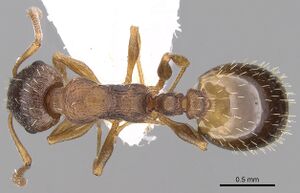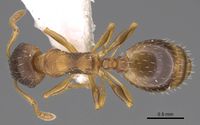Temnothorax angulinodis
| Temnothorax angulinodis | |
|---|---|

| |
| Scientific classification | |
| Kingdom: | Animalia |
| Phylum: | Arthropoda |
| Class: | Insecta |
| Order: | Hymenoptera |
| Family: | Formicidae |
| Subfamily: | Myrmicinae |
| Tribe: | Crematogastrini |
| Genus: | Temnothorax |
| Species group: | nylanderi |
| Species complex: | angulinodis |
| Species: | T. angulinodis |
| Binomial name | |
| Temnothorax angulinodis Csösz, Heinze & Mikó, 2015 | |
Nothing is known about the biology of Temnothorax angulinodis.
Identification
Csösz et al. (2015) - A member of the angulinodis species-complex. Due to the unique combination of the long spine, high petiole, and sharp transversal crest on the dorsum of the petiolar node this species is easily distinguishable from related taxa even by simple visual inspection.
Keys including this Species
Distribution
This species is known only from the Peloponnese peninsula.
Latitudinal Distribution Pattern
Latitudinal Range: 37.6607° to 36.9729°.
| North Temperate |
North Subtropical |
Tropical | South Subtropical |
South Temperate |
- Source: AntMaps
Distribution based on Regional Taxon Lists
Palaearctic Region: Greece (type locality).
Distribution based on AntMaps
Distribution based on AntWeb specimens
Check data from AntWeb
Countries Occupied
| Number of countries occupied by this species based on AntWiki Regional Taxon Lists. In general, fewer countries occupied indicates a narrower range, while more countries indicates a more widespread species. |

|
Estimated Abundance
| Relative abundance based on number of AntMaps records per species (this species within the purple bar). Fewer records (to the left) indicates a less abundant/encountered species while more records (to the right) indicates more abundant/encountered species. |

|
Biology
Castes
Worker
Images from AntWeb
   
| |
| Worker. Specimen code casent0906029. Photographer Estella Ortega, uploaded by California Academy of Sciences. | Owned by PCAS, Andreas Schulz Collection. |
   
| |
| Worker. Specimen code casent0906030. Photographer Estella Ortega, uploaded by California Academy of Sciences. | Owned by PCAS, Andreas Schulz Collection. |
Queen
Images from AntWeb
   
| |
| Queen (alate/dealate). Specimen code casent0906028. Photographer Estella Ortega, uploaded by California Academy of Sciences. | Owned by PCAS, Andreas Schulz Collection. |
Nomenclature
The following information is derived from Barry Bolton's Online Catalogue of the Ants of the World.
- angulinodis. Temnothorax angulinodis Csösz, Heinze & Mikó, 2015: 16, figs. 5A-C (w.) GREECE.
Unless otherwise noted the text for the remainder of this section is reported from the publication that includes the original description.
Description
Worker
Body color: brown. Body color pattern: mesosoma, antenna and legs excluding femora, waist and anterior region of 1st gastral tergite lighter than head, femora and posterior region of gaster. Absolute cephalic size: 594–657 μm (mean = 626, n = 8). Cephalic length vs. Maximum width of head capsule (CL/CWb): 1.171–1.222 (mean = 1.203). Postocular distance vs. cephalic length (PoOc/CL): 0.356–0.378 (mean = 0.368). Eye length vs. absolute cephalic size (EL/CS): 0.257–0.274 (mean = 0.265). Frontal carina distance vs. absolute cephalic size (FRS/CS): 0.366–0.388 (mean = 0.374). Median region of antennal rim vs. frontal carina in frontal view: not fully overlapped by frontal carina. Concentric carinae lateral to antennal foramen count: present. Carinae on medial region of frons shape: branched. Smooth median region on frons count: absent. Longitudinal carinae on median region of frons count: present. Median carina of clypeus count: present. Lateral carinae of clypeus count: present. Sculpture of submedian area of clypeus: smooth. Gena sculpture: rugoso-reticulate with feeble areolate ground sculpture. Gena frontal view shape: feebly convex. Genae contour from anterior view orientation: converging. Postocular sides of cranium contour frontal view orientation: converging posteriorly. Postocular side of cranium shape: feebly convex. Vertex sculpture: main sculpture homogenously forked costate, ground sculpture areolate; main sculpture dispersed forked costate sculpture, ground sculpture areolate. Posterior margin of vertex in frontal view shape: straight. Antennomere count: 12. Scape length vs. absolute cephalic size (SL/CS): 0.797–0.816 (mean = 0.808). Facial area of the scape absolute setal angle: 0–15°. External area of the scape absolute setal angle: 30°. Maximum mesosoma width vs. absolute cephalic size (MW/CS): 0.610–0.636 (mean = 0.621). Lateral region of pronotum sculpture: areolate ground sculpture, main sculpture forked costate. Dorsal region of mesosoma sculpture: rugulose with areolate ground sculpture. Metanotal depression count: present. Metanotal depression shape: shallow. Mesopleuron sculpture: areolate ground sculpture superimposed by dispersed rugulae. Metapleuron sculpture: areolate ground sculpture superimposed by dispersed rugulae. Spine length vs. absolute cephalic size (SPST/CS): 0.332–0.369 (mean = 355). Median anatomical line of propodeal spine vs. to Weber length angle value in lateral view: 32–38°. Apical spine distance vs. absolute cephalic size (SPTI/CS): 0.366–0.398 (mean = 0.386). Maximum spine distance vs. absolute cephalic size (SPWI/CS): 0.390–0.419 (mean = 0.409). Minimum spine distance vs. absolute cephalic size (SPBA/CS): 0.262–0.304 (mean = 0.285). Anterodorsal rim of petiole count: present. Anterodorsal edge of petiole dorsal view shape: semicircular. Truncate dorsum of petiolar node count: absent. Truncate dorsum dorsal side contour lateral view: absent. Frontal profile of petiolar node in lateral view shape: straight. Anterodorsal edge of petiole count: present. Anterodorsal edge of petiole angle value: 72–82°. Dorsal region of petiole sculpture: ground sculpture areolate, main sculpture dispersed costulate. Posterodorsal edge of petiole count: absent. Caudal petiolar profile shape: straight; convex. Caudal petiolar profile angle value to ventral margin of petiole: more than 80°. Dorsal region of postpetiole sculpture: ground sculpture areolate, main sculpture dispersed costulate.
Type Material
Holotype: Greece_27 Peloponnesus, 22 km NNW Tripolis, Menalo Oros, 37.6539N, 22.2676E, 1500-1700mH, 29.IV.2011, leg. A. Schulz “256”, (Hungarian Natural History Museum), [GRE:Tripolis-22NNW-20110429-256].
Paratypes: Greece_27, Peloponnesus, 22 km NNW Tripolis, Menalo Oros, 37.6539N, 22.2676E, 1500-1700mH, 29.IV.2011, leg. A. Schulz “256”, (2## HNHM, 1# California Academy of Sciences CASENT0906029; CASENT0914688), [GRE:Tripolis-22NNW-20110429-256]; Greece, Peloponnesus, Melanos Oros, 20 km NNW. Tripolis, 5 km SW. Levidion, 37.6607N, 22.2546E, 1700mH, 03.06.1994, leg. A. Schulz “1380”, (3## HNHM), [GRE:Levidion-5SW-19940603-1380]; Greece, Peloponnesus, Melanos Oros, 20 km NNW. Tripolis, 5 km SW. Levidion, 37.6607N, 22.2546E, 1700mH, 03.06.1994, leg. A. Schulz “1383” (2## HNHM), [GRE:Levidion-5SW-19940603-1383].
Etymology
This name “angulinodis” refers to the sharply angulate profile of the petiolar node of this species.
References
- Csösz, S., Heinze, J., Mikó, I. 2015. Taxonomic synopsis of the Ponto-Mediterranean ants of Temnothorax nylanderi species-group. PLoS ONE 10(11): e0140000 (doi:10.1371/journal.pone.0140000).
- Salata, S., Borowiec, L. 2019. Preliminary division of not socially parasitic Greek Temnothorax Mayr, 1861 (Hymenoptera, Formicidae) with a description of three new species. ZooKeys 877: 81-131 (doi:10.3897/zookeys.877.36320).
References based on Global Ant Biodiversity Informatics
- Borowiec L., and S. Salata. 2017. Ants of the Peloponnese, Greece (Hymenoptera: Formicidae). Polish Journal of Entomology 86: 193-236.
- Csősz S, Heinze J, and I. Mikó. 2015. Taxonomic synopsis of the Ponto-Mediterranean ants of Temnothorax nylanderi species-group. PLoS ONE 10(11): e0140000. doi:10.1371/journal.pone.0140000

